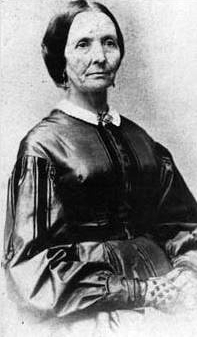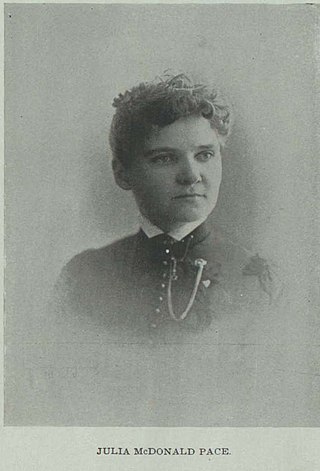
Eliza Roxey Snow was one of the most celebrated Latter-day Saint women of the nineteenth century. A renowned poet, she chronicled history, celebrated nature and relationships, and expounded scripture and doctrine. Snow was married to Joseph Smith as a plural wife, and was a plural wife to Brigham Young after Smith's death. Snow was the second general president of the Relief Society of the Church of Jesus Christ of Latter-day Saints, which she reestablished in the Utah Territory in 1866. She was also the older sister of Lorenzo Snow, the LDS Church's fifth president.
Mormon fiction is generally fiction by or about members of the Church of Jesus Christ of Latter-day Saints, who are also referred to as Latter-day Saints or Mormons. Its history is commonly divided into four sections as first organized by Eugene England: foundations, home literature, the "lost" generation, and faithful realism. During the first fifty years of the church's existence, 1830–1880, fiction was not popular, though Parley P. Pratt wrote a fictional Dialogue between Joseph Smith and the Devil. With the emergence of the novel and short stories as popular reading material, Orson F. Whitney called on fellow members to write inspirational stories. During this "home literature" movement, church-published magazines published many didactic stories and Nephi Anderson wrote the novel Added Upon. The generation of writers after the home literature movement produced fiction that was recognized nationally but was seen as rebelling against home literature's outward moralization. Vardis Fisher's Children of God and Maurine Whipple's The Giant Joshua were prominent novels from this time period. In the 1970s and 1980s, authors started writing realistic fiction as faithful members of the LDS Church. Acclaimed examples include Levi S. Peterson's The Backslider and Linda Sillitoe's Sideways to the Sun. Home literature experienced a resurgence in popularity in the 1980s and 1990s when church-owned Deseret Book started to publish more fiction, including Gerald Lund's historical fiction series The Work and the Glory and Jack Weyland's novels.

Mormon poetry is poetry written by members of the Church of Jesus Christ of Latter-day Saints about spiritual topics or themes. Mormons have a long history of writing poetry relevant to their religious beliefs and to the Mormon experience. Mormon poetry, like Mormon fiction, has experienced different periods throughout the LDS Church's history, including the "home literature" period and the "lost generation." Some Mormon poetry became church hymns.

Louisa Lula Greene Richards was a poet and was the first female periodical editor in Utah Territory. Richards's work was published under a variety of names, including Louisa L. Greene, Louise L. Green, Lula Green, and Lula G. Richards. She was a member of the Church of Jesus Christ of Latter-day Saints.
Emily Hill Woodmansee was an English-born American Mormon poet and hymnwriter. Although only one of her hymns "As Sisters In Zion" is included in the 1985 LDS English language edition of the LDS Church's hymnbook, previous LDS Church hymnbooks have included more of her works.
Douglas H. Thayer was a prominent author in the "faithful realism" movement of Mormon fiction. He has been called the "Mormon Hemingway" for his straightforward style and powerful prose. Eugene England called him the "father of contemporary Mormon fiction."

Ronald Davis Bitton was a charter member and president of the Mormon History Association, professor of history at the University of Utah, and official Assistant Church Historian in the Church of Jesus Christ of Latter-day Saints working with Leonard J. Arrington.
Richard Eyring "Rick" Turley Jr. is an American historian and genealogist. He previously served as both an Assistant Church Historian of the Church of Jesus Christ of Latter-day Saints and as managing director of the church's public affairs department.
The Association for Mormon Letters (AML) is a nonprofit organization founded in 1976 to "foster scholarly and creative work in Mormon letters and to promote fellowship among scholars and writers of Mormon literature." Other stated purposes have included promoting the "production and study of Mormon literature" and the encouragement of quality writing "by, for, and about Mormons." The broadness of this definition of LDS literature has led the AML to focus on a wide variety of work that has sometimes been neglected in the Mormon community. It publishes criticism on such writing, hosts an annual conference, and offers awards to works of fiction, poetry, essay, criticism, drama, film, and other genres. It published the literary journal Irreantum from 1999 to 2013 and currently publishes an online-only version of the journal, which began in 2018. The AML's blog, Dawning of a Brighter Day, launched in 2009. As of 2012, the association also promotes LDS literature through the use of social media. The AML has been described as an "influential proponent of Mormon literary fiction."
The AML Awards are given annually by the Association for Mormon Letters (AML) to the best work "by, for, and about Mormons." They are juried awards, chosen by a panel of judges. Citations for many of the awards can be found on the AML website.
Emma Lou Warner Thayne was a poet and novelist. She was a member of the Church of Jesus Christ of Latter-day Saints and counted as one of the 75 most significant Mormon poets.
Linda Buhler Sillitoe was an American journalist, poet and historian. She is best known for her journalistic coverage about Mark Hofmann and the "Mormon forgery murders." Her subsequent book Salamander, coauthored with Allen Roberts, examined Hofmann's creation of an industry for forged documents, the 1985 bombing murders of two people, and the police investigation, arrest and conviction. The murder investigation eventually revealed Hofmann's documents, initially seen as undermining the early history of the Church of Jesus Christ of Latter-day Saints, were forgeries. Sillitoe’s published works also included fiction and poetry.

Mormonism: A Historical Encyclopedia (2010) is an encyclopedia designed for a general readership about topics relating to the History of the Church of Jesus Christ of Latter-day Saints. The book was edited by W. Paul Reeve and Ardis E. Parshall. Reeve is a professor of history at the University of Utah and Parshall is an independent historian, newspaper columnist, and freelance researcher.

Irreantum is a literary journal compiled and published by the Association for Mormon Letters (AML) from 1999 to 2013, with online-only publication starting in 2018. It features selections of LDS literature, including fiction, poetry, and essays, as well as criticism of those works. The journal was advertised as "the only magazine devoted to Mormon literature." In its first years of publication, Irreantum was printed quarterly; later, it was printed twice a year. A subscription to the magazine was included in an AML membership. Annual Irreantum writing contests were held, with prizes for short stories, novel excerpts, poems, and nonfiction awarded. The journal's creators, Benson Parkinson and Chris Bigelow, sought to create a publication that would become a one-stop resource where companies interested in publishing LDS literature could find the best the subculture had to offer. They also hoped Irreantum would highlight various kinds of LDS writing, balancing both liberal and traditional points of view.
Keepapitchinin is a history blog written by American historian Ardis E. Parshall,) who specializes in Mormon history. The site was founded in 2008, whose namesake comes from a humorous newspaper published sporadically between 1867 and 1871 and was pseudonymously written by George J. Taylor, Joseph C. Rich, and Heber John Richards (the fathers of whom each served at the time as apostles in the Church of Jesus Christ of Latter-day Saints. Parshall received an award in 2010 for her Keepapitchinin essay "Beards" from the Association of Mormon Letters and was awarded by the Bloggernacle as 2010 Best Blogger and 2008, 2009, 2012, and 2013 Best Solo Blog. Parshall's article "'Pursue, Retake & Punish’: The 1857 Santa Clara Ambush" received the 2005 Dale L. Morgan Award of the Utah State Historical Society.
Ardis E. Parshall is an "independent historian" who researches Latter-day Saint history. Parshall has published her research on her blog, Keepapitchinin. In addition to her research work, Parshall worked for the Salt Lake Tribune as a historical writer from 2005 to 2011. She also published a book entitled, The Corianton Saga. Parshall has co-edited books including Mormonism: A Historical Encyclopedia and Dime Novel Mormons.
W. Paul Reeve is an American historian and Simmons Professor of Mormon Studies and History in the History Department at the University of Utah. He became chair of the History Department on 1 July 2022.

Julia Ann Ivins McDonaldPace, who wrote under the name Julia McDonald, was a scholar, medical student and writer who was born in Utah Territory in 1859. She was a members of The Church of Jesus Christ of Latter-day Saints and was part of the Mormon Home literature movement in the late 19th and early 20th centuries. She is best known as the author of the novel A Ship of Hagoth (1896), which was adapted in two stage plays and the 1931 motion picture Corianton: A Story of Unholy Love.

Michael Austin is an American academic, university administrator, author, and critic, specialising in the study of Mormon literature. In 2022, he was given the Lifetime Achievement Award from the Association for Mormon Letters. He is the provost and vice president for academic affairs at Snow College.

Songs and Flowers of the Wasatch is a book of poetry edited by Emmeline B. Wells and illustrated by Edna Wells Sloan. Several copies, with hand-painted illustrations, were exhibited at the 1893 World's Columbian Exposition in the Women's Building Library and the Utah Building. Utah women poets wrote the book's thirty-four poems, which focused on Utah's landscape and Mormon theology. Reviews when the book came out focused on the book itself as an art object. Mormon historians see the book as Utah women's attempt to assimilate to cultural expectations of citizens of the United States of America.









